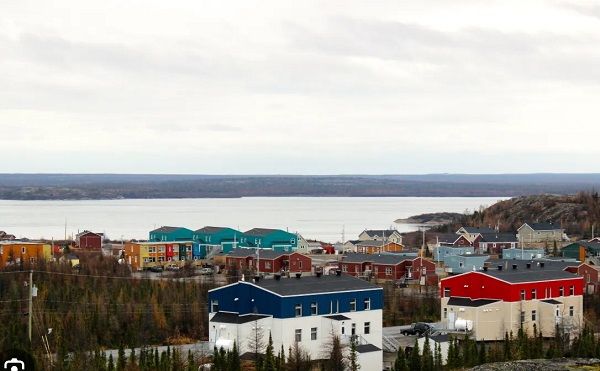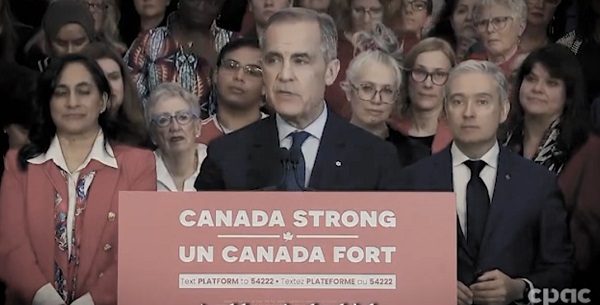Alberta
With a boost of up to $200 million from the Province, Inter Pipeline Ltd. investing $600 million in new petrochemical plant east of Edmonton

Premier Notley announces private investment in a new petrochemical upgrading facility alongside David Chappell (r), Patrick Bergen and Pyramid Prefab Piping staff.
From the Province of Alberta
Made-in-Alberta plan attracts new jobs, investment
Alberta is taking a significant step forward on a more diversified economy with a project that supports hundreds of jobs and adds more value to our energy resources.
If the plan is finalized, Inter Pipeline Ltd. would invest about $600 million in a new petrochemical upgrading facility that would produce more valuable consumer products derived from propane, including acrylic acid that is used in many everyday consumer products. This major private investment is unlocked by support from Premier Rachel Notley’s Made-in-Alberta energy diversification strategy.
The project would build on the company’s supply and knowledge of propylene, a product it already produces at the company’s other petrochemical facilities east of Edmonton. Construction would create about 600 jobs with another 50 long-term positions supporting the local economy once the facility is fully up and running.
“For decades, Albertans settled for less while new jobs and investment went south of the border. So we’re grabbing the bull by the horns, fighting for a Made-in-Alberta plan that represents the single largest energy diversification effort since the days of Peter Lougheed. We’re proud to support upgrading projects like Inter Pipeline’s because they mean more good jobs and top dollar for the energy resources that belong to all Albertans.”
Inter Pipeline’s supply of propylene, a gas that results from adding value to raw propane, creates the opportunity to further leverage Alberta’s natural resource strengths and extend the value chain. By producing acrylic acid used in things like adhesives, floor polishes and paints, this project increases the likelihood of attracting investments in more manufacturing facilities in the future.
“Alberta’s abundance of natural resources has positioned Inter Pipeline to invest in opportunities like this that build on our strengths to extend the value chain and make products that are in demand around the world. We want to commend this government for fostering the environment for companies like ours to grow and create jobs, while competitively positioning our business in the world market.”
The announcement was made at Pyramid Prefab Piping, one of the hundreds of companies across the province benefiting from the Made-in-Alberta strategy. As a manufacturer that employs about 45 people in Calgary, Pyramid was contracted to build key components for Inter Pipeline’s project already under construction.
“We’re pleased to see the government’s vision for the future is focused on jobs and diversification, which will lead to more work for companies like ours to build the components needed for energy upgrading projects. This growth means we can put even more skilled tradespeople to work in the Calgary region and contribute even more to the oil and gas sector.”
If finalized by Inter Pipeline, the private investment would be unlocked by provincial support of up to $70 million in future royalty credits under the Petrochemicals Diversification Program, which was first developed in early 2016.
Quick facts
- Inter Pipeline’s acrylic acid and propylene derivatives facility would be in Alberta’s Industrial Heartland, northeast of Edmonton. Construction is expected to begin in 2021.
- The facility would convert 60,000 tonnes per year of propylene and produce 80,000 tonnes per year of propylene derivatives, including acrylic acid, when operational.
- Acrylic acid is a value-added product used to make coatings, adhesives, diapers, floor polishes and paints.
- Roughly 50 skilled, local permanent jobs and 600 skilled trade construction jobs would be created.
- Inter Pipeline has already been approved to receive up to $200 million in future royalty credits from the first round of the Petrochemicals Diversification Program for the construction its $3.5-billion Heartland Petrochemical Complex.
Background
Made-in-Alberta energy strategy
- Premier Notley’s government is investing $3 billion to support energy diversification that creates jobs and adds value to our resources here at home.
- The focus is on two key areas: partial upgrading of our bitumen and petrochemical processing that adds value to natural gas and natural gas liquids.
- Overall, this commitment is expected to attract more than $25 billion in private-sector investment to Alberta and create more than 20,000 jobs.
Petrochemical upgrading
- Support for the Inter Pipeline facility is provided under the petrochemical portion of the Made-in-Alberta strategy.
- Two projects – owned by the Canada-Kuwait Petrochemical Corporation and Inter Pipeline Ltd. – were selected under the first round of this program, which was announced in 2016. The projects combined for $8 billion in private investment, creating more than 5,000 jobs.
- The government announced a second round of support for petrochemical upgrading in 2018.
- Nauticol’s methanol facility was previously selected under the second round of this program. The entire project is a $2-billion private investment in a plant near Grande Prairie, creating roughly 3,000 direct and indirect jobs.
- Albertans and Canadians use dozens of products every day that are based in part on petrochemicals like those from Alberta’s growing value-added industry including:
- polyester fabric couches, HD televisions, phones coffeemakers and computers
- car tires, engine hoses, gas, oil, radio components and seats
- desks, chairs, computers, carpets, cellphones and other office supplies
Partial upgrading of bitumen
- $1 billion in grants and loan guarantees to encourage companies to invest in new or expanded bitumen-upgrading facilities.
- Partial upgrading reduces the thickness of oil sands bitumen so it can flow through pipelines more easily, without having to be blended with diluent or as much diluent, a thinning agent. Benefits include:
- increased prices for our resources before shipping
- up to 30 per cent more capacity on existing pipelines
- more world refineries capable of processing our product
- cost savings on diluent for industry
- fewer emissions by removing high carbon content
Energy diversification timeline
- January 2016 – Royalty Review Advisory Panel recommended more value-add within the province, including partial upgrading
- February 2016 – Petrochemicals Diversification Program (PDP) introduced
- October 2016 – Energy Diversification Advisory Committee (EDAC) formed
- December 2016 – First PDP projects awarded
- December 2017 – Inter Pipeline finalized investment in petrochemical project
- February 2018 – EDAC reported back, including recommendation of partial upgrading, more PDP and additional support for petrochemical feedstock infrastructure
- March 2018 – Government launched programs through the Energy Diversification Act
- Fall 2018 – oil price differential hit crisis point. In response, government took several actions:
- Temporary limit on oil production
- Doubled support for PDP
- Began crude-by-rail negotiations
- Appointed LNG Investment Team
- Request for industry interest in building refining capacity
- January 2019 – Government announced letter of intent for first partial upgrading project awarded (Value Creation Inc.)
- February 2019 – Canada-Kuwait Petrochemical Corporation finalized investment in petrochemical project
- February 2019 – Premier announced crude-by-rail agreements
- February 2019 – Nauticol awarded first project under second round of PDP
Alberta
Made in Alberta! Province makes it easier to support local products with Buy Local program

Show your Alberta side. Buy Local. |
When the going gets tough, Albertans stick together. That’s why Alberta’s government is launching a new campaign to benefit hard-working Albertans.
Global uncertainty is threatening the livelihoods of hard-working Alberta farmers, ranchers, processors and their families. The ‘Buy Local’ campaign, recently launched by Alberta’s government, encourages consumers to eat, drink and buy local to show our unified support for the province’s agriculture and food industry.
The government’s ‘Buy Local’ campaign encourages consumers to buy products from Alberta’s hard-working farmers, ranchers and food processors that produce safe, nutritious food for Albertans, Canadians and the world.
“It’s time to let these hard-working Albertans know we have their back. Now, more than ever, we need to shop local and buy made-in-Alberta products. The next time you are grocery shopping or go out for dinner or a drink with your friends or family, support local to demonstrate your Alberta pride. We are pleased tariffs don’t impact the ag industry right now and will keep advocating for our ag industry.”
Alberta’s government supports consumer choice. We are providing tools to help folks easily identify Alberta- and Canadian-made foods and products. Choosing local products keeps Albertans’ hard-earned dollars in our province. Whether it is farm-fresh vegetables, potatoes, honey, craft beer, frozen food or our world-renowned beef, Alberta has an abundance of fresh foods produced right on our doorstep.
Quick facts
- This summer, Albertans can support local at more than 150 farmers’ markets across the province and meet the folks who make, bake and grow our food.
- In March 2023, the Alberta government launched the ‘Made in Alberta’ voluntary food and beverage labelling program to support local agriculture and food sectors.
- Through direct connections with processors, the program has created the momentum to continue expanding consumer awareness about the ‘Made in Alberta’ label to help shoppers quickly identify foods and beverages produced in our province.
- Made in Alberta product catalogue website
Related information
Alberta
Province to expand services provided by Alberta Sheriffs: New policing option for municipalities

Expanding municipal police service options |
Proposed amendments would help ensure Alberta’s evolving public safety needs are met while also giving municipalities more options for local policing.
As first announced with the introduction of the Public Safety Statutes Amendment Act, 2024, Alberta’s government is considering creating a new independent agency police service to assume the police-like duties currently performed by Alberta Sheriffs. If passed, Bill 49 would lay additional groundwork for the new police service.
Proposed amendments to the Police Act recognize the unique challenges faced by different communities and seek to empower local governments to adopt strategies that effectively respond to their specific safety concerns, enhancing overall public safety across the province.
If passed, Bill 49 would specify that the new agency would be a Crown corporation with an independent board of directors to oversee its day-to-day operations. The new agency would be operationally independent from the government, consistent with all police services in Alberta. Unlike the Alberta Sheriffs, officers in the new police service would be directly employed by the police service rather than by the government.
“With this bill, we are taking the necessary steps to address the unique public safety concerns in communities across Alberta. As we work towards creating an independent agency police service, we are providing an essential component of Alberta’s police framework for years to come. Our aim is for the new agency is to ensure that Albertans are safe in their communities and receive the best possible service when they need it most.”
Additional amendments would allow municipalities to select the new agency as their local police service once it becomes fully operational and the necessary standards, capacity and frameworks are in place. Alberta’s government is committed to ensuring the new agency works collaboratively with all police services to meet the province’s evolving public safety needs and improve law enforcement response times, particularly in rural communities. While the RCMP would remain the official provincial police service, municipalities would have a new option for their local policing needs.
Once established, the agency would strengthen Alberta’s existing policing model and complement the province’s current police services, which include the RCMP, Indigenous police services and municipal police. It would help fill gaps and ensure law enforcement resources are deployed efficiently across the province.
Related information
-

 Alberta2 days ago
Alberta2 days agoProvince to expand services provided by Alberta Sheriffs: New policing option for municipalities
-

 Bruce Dowbiggin1 day ago
Bruce Dowbiggin1 day agoIs HNIC Ready For The Winnipeg Jets To Be Canada’s Heroes?
-

 2025 Federal Election1 day ago
2025 Federal Election1 day agoCSIS Warned Beijing Would Brand Conservatives as Trumpian. Now Carney’s Campaign Is Doing It.
-

 Alberta2 days ago
Alberta2 days agoMade in Alberta! Province makes it easier to support local products with Buy Local program
-

 2025 Federal Election2 days ago
2025 Federal Election2 days agoNo Matter The Winner – My Canada Is Gone
-

 Health1 day ago
Health1 day agoHorrific and Deadly Effects of Antidepressants
-

 2025 Federal Election1 day ago
2025 Federal Election1 day agoCampaign 2025 : The Liberal Costed Platform – Taxpayer Funded Fiction
-

 2025 Federal Election1 day ago
2025 Federal Election1 day agoA Perfect Storm of Corruption, Foreign Interference, and National Security Failures

